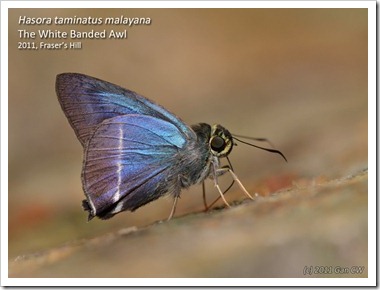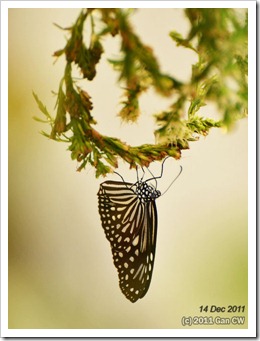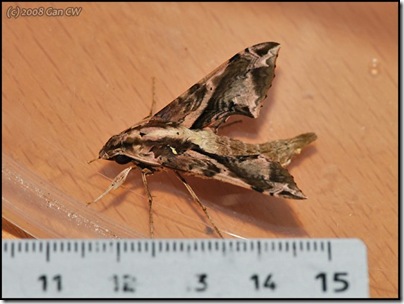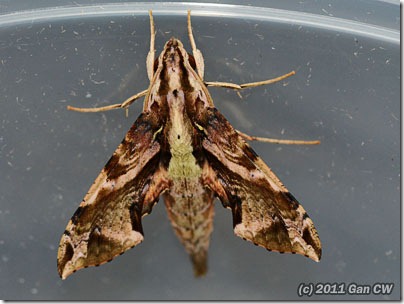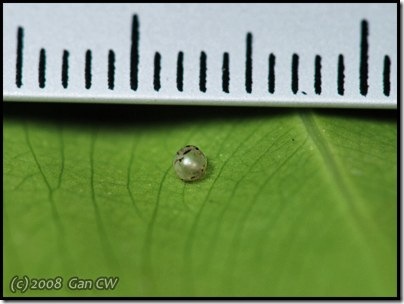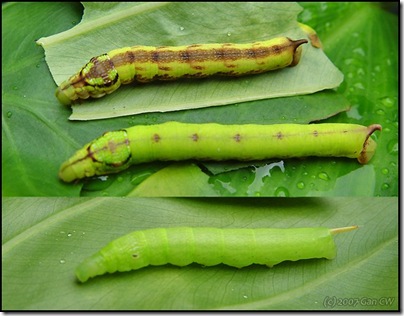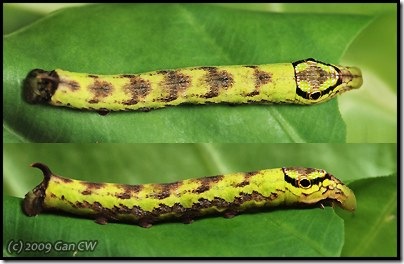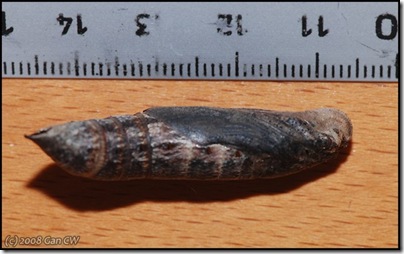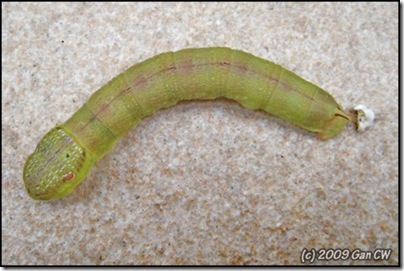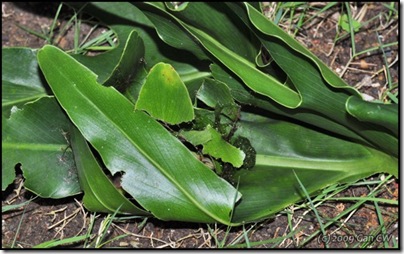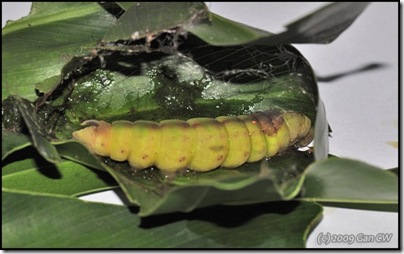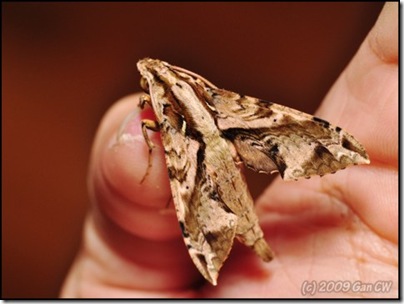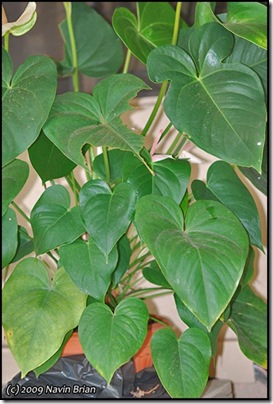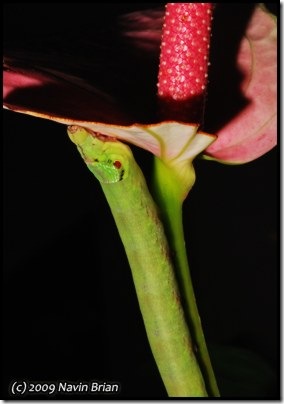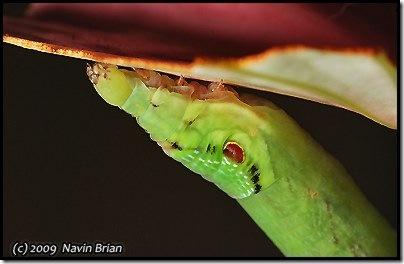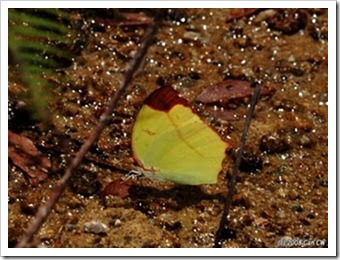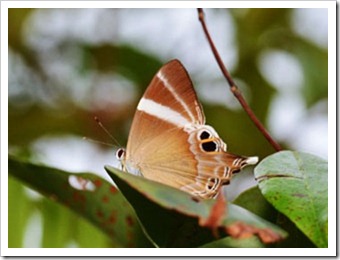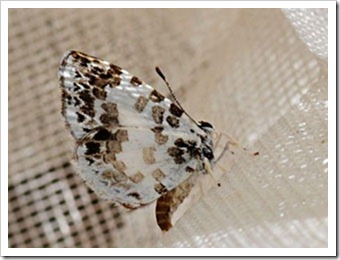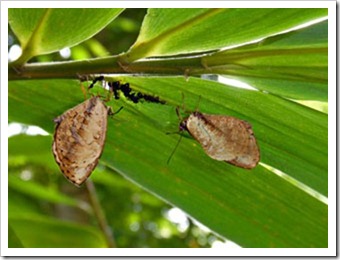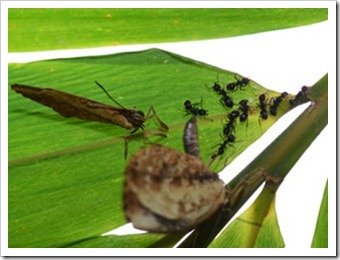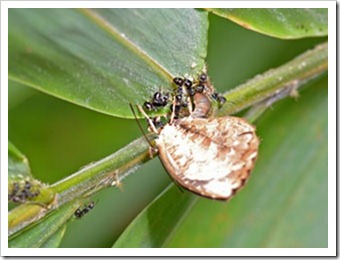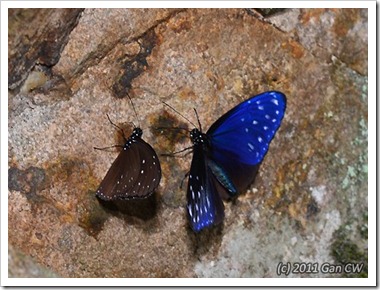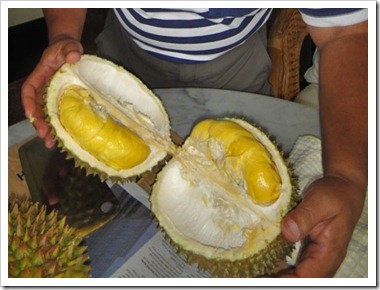Friday, December 30, 2011
Butterfly Species #18 in my garden
The crow must have came from West Coast Park where there are many Pong Pong trees (Cerbera odollam), its larva host plant. It must have been attracted by my Dill plant. On 14 Dec, I spotted a Dark Glassy Tiger (Parantica agleoides agleoides) circling my dill plant and it stayed for 2 days before disappearing.
Tuesday, December 20, 2011
Eupanacra elegantulus (Herrich-Schaeffer, [1856])
Name : Eupanacra elegantulus (Herrich-Schaeffer, [1856])
Family : SPHINGIDAE Latreille, 1802
Subfamily : MACROGLOSSINAE Harris, 1839
Tribe : Macroglossini Harris, 1839
Larva host plant : Alocasia, Diffenbachia, Anthurium, Philodendron
Female : Mar 2008 Singapore
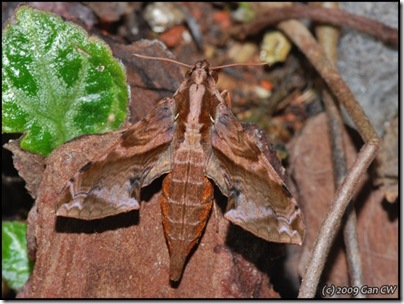
Female : Mar 2008 Singapore 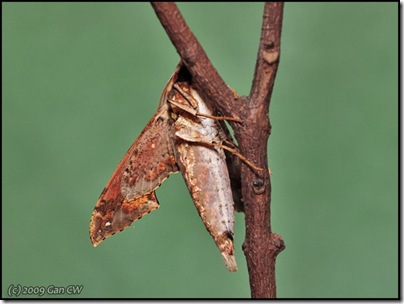
Jan 2009 Singapore
Reference : The Sphingidae of Southeast-Asia
Life History Record :
- Dec 2011– Diffenbachia
- May 2009– Colocosia Black Magic
- Apr 2009 – Anthurium
- Jan 2009 - Philodendron selloum
- Mar 2008 – Alocacsia and Diffenbachia
| Date : 3 Dec 2011 source : Gan Location : MacRitchie Reservoir, Singapore Host plant : Diffenbachia 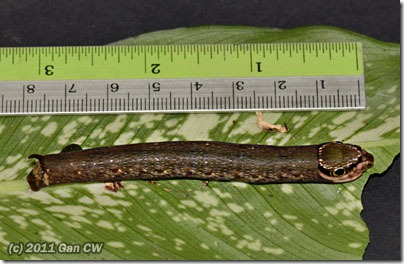 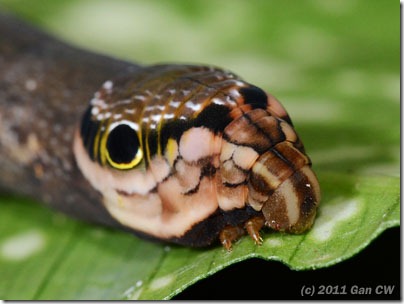 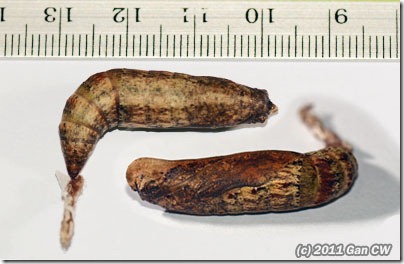 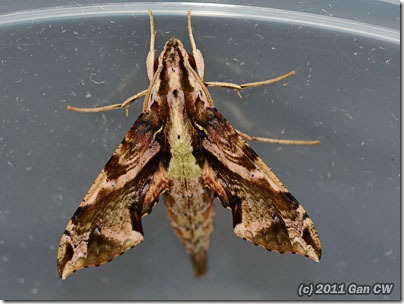 |
| Date : 25 May 2009 source : GCS member “wolfman” Location : Along Pasir Panjang Road, Singapore Host plant : Colocasia Black Magic 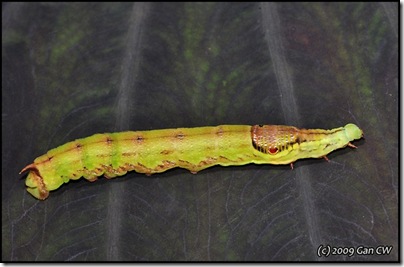 |
| Date : 9 Jan 2009 Larva : 5th instar |
| Date : April 2009 |
Monday, November 7, 2011
The Tailed Sulphur, Dercas gobrias herodorus (Fruhstorfer)
From a far, this species can be easily mistaken for a large Eurema, Gandaca or Catopsilia, especially when it is puddling with other Pierids. However, its unique angled wing and blackish brown quadrate spot on the apex of the forewing makes it distintive and cannot be mistaken for any other species in Malaysia.
The larva host plant for D. gobrias is Dalbergia benthami, a plant that looks a bit like the Rattlebox pea plant (Crotalaria sp).

Note: The species that is found in West Malaysia has been reclassified as Dercas gobrias herodorus.The reason for the change is because D. verhuelli is a continental species and can only be found in India, Myanmar, Thailand, Vietnam and southern China while D. gobrias is found in found Peninsula Malaysia, Sumatra, Borneo and Java.
Thursday, August 25, 2011
Back to Fraser’s Hill - 3rd time lucky – Part II
Continue from Part I
We did not have the best of weather this trip as the sky was cloudy most of time. However, we still managed to see many lovely butterflies which sprang into action every time the sun made a brief appearance.
1. Abisara neophron chelina – this species is confined to the highland and is common at Fraser’s Hill.
2. Abisara savitri savitri – This is found at lowland and is the species we have in Singapore. This one was photographed at 600m.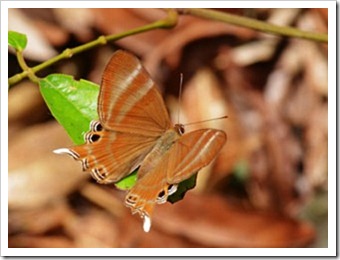
3. Dichorragia nesimachus deiokes (The Constable) – this lovely Nymphalid only stayed for less than a minute before disappearing back into the forest.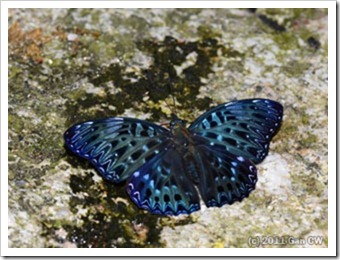
4. Papilio demolion demolion (Banded Swallowtail) – A common swallowtail at the foothill of Fraser’s hill. 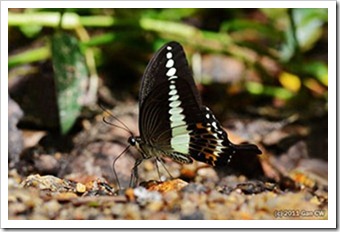
5. Troides brookiana albescens (Rajah Brooke’s Birdwing)
This is the national butterfly of Malaysia and is also the most beautiful butterfly in Malaysia. I have seen this butterfly countless time and yet every time it make its appearance I will instinctively pause to admire its graceful flight and its lovely electric-green over velvety black wings.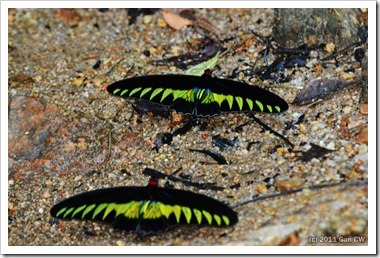
Sunday, August 7, 2011
Back to Fraser’s Hill - 3rd time lucky – Part I
This is my third trip to Fraser’s Hill and I have 3 lifer !
The first is a small white inconspicuous lycaenid. I was trailing an Abisara savitri when I noticed a tiny white ‘moth’ flew out form under a leaf. It has a weak moth-like flight and is about the size of a Lesser Grass Blue butterfly. I ignored it and continued to photograph the Abisara. The white moth then landed in front of me and I noticed it has clubbed antenna. It is not a moth ! I quickly snap a few shots and it turned out to be an uncommon lycaenid – Takara mahanetra.
My 2nd lifer was observed in the most unlikely place, inside Puncak Inn. It was in the evening and we were at Puncak Inn having our lemon tea when I noticed 2 butterflies trapped under the glass roof. Both were Arhopala but one looks interesting.
I borrowed Jee Kin’s camera which has the Tamron 180 on it, and took a few shots. It turned out to be another lifer for me ! It is Arhopala paraganesa mendava. According to book ‘Butterfly of Malay Peninsula’, this species is rare and confined to montane. This individual was recorded at 1000m.
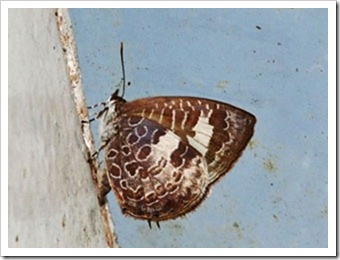 Arhopala paraganesa mendava
Arhopala paraganesa mendava
I encountered my 3rd lifer while we were checking out a road leading to an Orang Asli settlement. We saw a few small lycaenids fluttering under a cluster of bamboo leaves.
On closer examination, we recognized the lycaenid as Miletus sp. The female were laying eggs where there were cluster of ants.
The lycaenid was later identified as Miletus gallus gallus.
Saturday, May 7, 2011
Jewels from Fraser’s Hill, May 2011
This is my 2nd trip to Fraser’s Hill this year and one of my all time best ! The best because we had the pleasure to feast on the authentic and BEST ‘Mao Shan Wang’ (Gua Musang) durian in Malaysia and I saw many spectacular and rare butterflies out of which 2 are lifer* for me :
- Graphium empedovana
- Chilasa paradoxa aenigma -f. eucyana
- Lamproptera, most likely L. meges.
- Ixias pyrene alticola
- Amathuxidia amythaon dilucida
- Sumalia daraxa theoda
- Hestina nama nama*
- Prothoe franck uniformis*
Here are some butterfly photos from the trip :
Female Yellow Orange Tip (Ixias pyrene alticola) – a subspecies found on highland, the female can be easily mistaken for other pierinae. 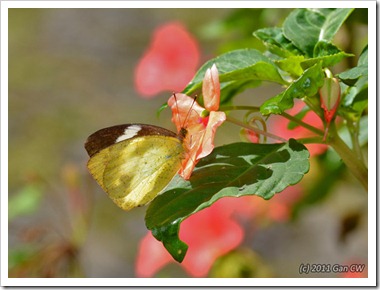
The Banded Puffin (Appias pandione lagela)– a common pierinae at Fraser’s hill. 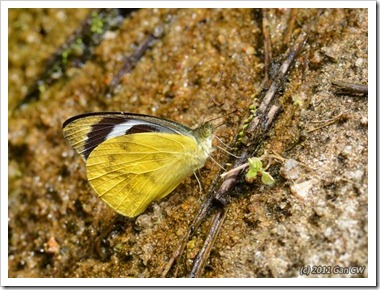
The Yellow Glassy Tiger- a common butterfly at Fraser’s Hill. 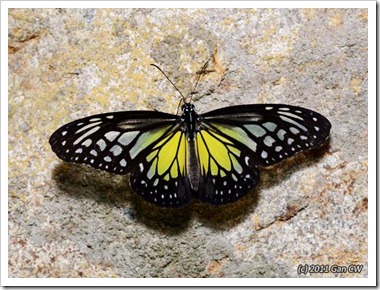
The Striped Blue Crows, sipping seepage from on rock surface.
The Blue Begum and Koh-I-Noor – both are rare and were sighted at the same location ! Awesome !
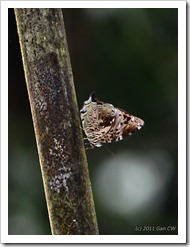
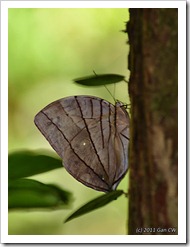
Staff Sergeant (Athyma selenophora selenophora) 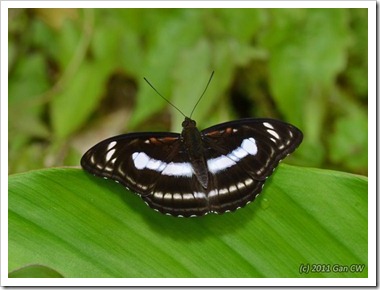
The Green Commodore (Sumalia daraxa theoda) - A highland species which like to settle high above ground, can be mistaken for a small G. sarpedon. This is the first time I managed to photograph this species. 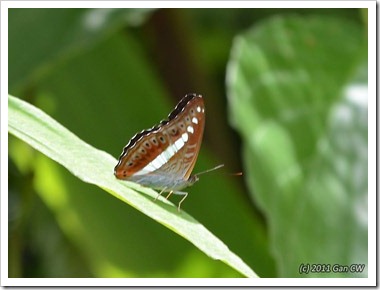
The Common Nawab - common but always a joy to watch and photograph.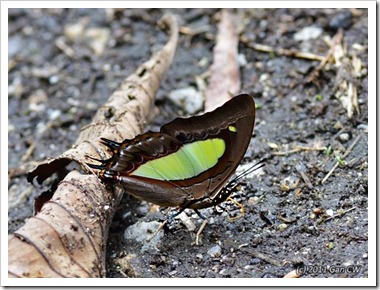
The Circe – flies and looks like a Chestnut Tiger ! It will trick all but the true expert. RARE ! Jackpot !!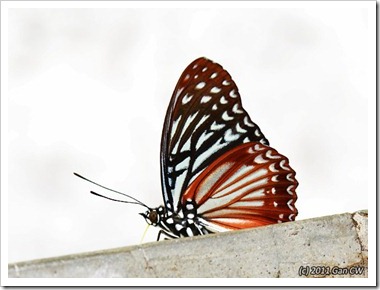
The Larger Yamfly (Loxura cassiopeia cassiopeia)
The White Banded Awl – one of the more colourful Awls.